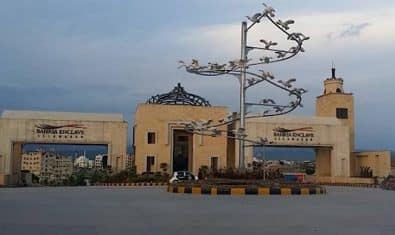The use of modern methods of irrigation in rural areas of Pakistan is minimal or nonexistent as only 1.44 percent of rural areas reported usage of modern methods all over the country, states the Pakistan Bureau of Statistics (PBS).
The Bureau, in its latest report “Key finding report of mouza Census -2020,” stated that usage of modern irrigation systems has almost the same pattern in provinces. However, Khyber Pakhtunkhwa reported 3 percent usage while Sindh and Balochistan reported just 0.4 percent and 0.2 percent usage of modern methods. The use of Drip systems for irrigation is more prevalent, and its usage is highest in Khyber Pakhtunkhwa with 3 percent.
It further stated that the average depth of underground water in the majority of rural areas is up to 100 feet. However, there are stark differences in different provinces. In Punjab and Sindh, more than 75 percent of rural areas have a depth of underground water up to 100 feet, and in Khyber Pakhtunkhwa and Balochistan, the majority of rural areas have a water depth of 101 feet.
Availability of electricity to all parts of Mouzas overall Pakistan has significantly approved in 2020. Currently, 50 percent of Mouzas have electricity in all parts compared to 35 percent in 2008. However, 16 percent of rural areas of Pakistan still do not have electricity, the report noted.
Among provinces, Punjab, with 65 percent, has the highest percentage of areas where electricity is available in all parts of Mouzas compared to only 19 percent in Balochistan. 50 percent of rural areas in Balochistan do not have electricity, followed by 24 percent in Khyber Pakhtunkhwa.
The report noted that natural disasters badly affect the livelihood of people in general but are more devastating for rural populations due to significant dependence on agriculture and livestock activities. It is found that 74 percent of rural areas were not affected by any major natural disaster in the last five years.
However, among the areas which faced any disaster, the highest percentage is of drought with 14 percent, followed by flood with 8 percent. However, the situation varies within provinces, and it is observed that majorly rural areas of Balochistan and Sindh have been affected by droughts with 58 percent and 17 percent, respectively, followed by rural areas of Khyber Pakhtunkhwa with 12 percent.
In terms of floods, rural areas of Balochistan have been affected severely in the last five years with 14 percent, followed by Khyber Pakhtunkhwa with 11 percent. However, natural disasters, in terms of earthquakes, are mainly faced by the rural population of Khyber Pakhtunkhwa with 20 percent followed by 4 percent rural areas affected in Balochistan. Rural areas of Punjab were the least affected by any natural disasters in the last five years.
It is observed that the majority of rural areas, i.e., 92 percent in Pakistan, are devoid of Large Scale and Medium scale industries. However, there is some concentration of small-scale and cottage industries with approximately 4 percent each.
Among provinces, rural areas of Sindh and Punjab have the highest prevalence of small industries, with 5 percent each. Rural areas of Sindh also have the highest concentration of cottage industries with 6 percent, followed by 5 percent in Khyber Pakhtunkhwa. Rural areas of Punjab have the highest concentration of medium-scale industries with 2 percent compared to other provinces, the report noted.





















